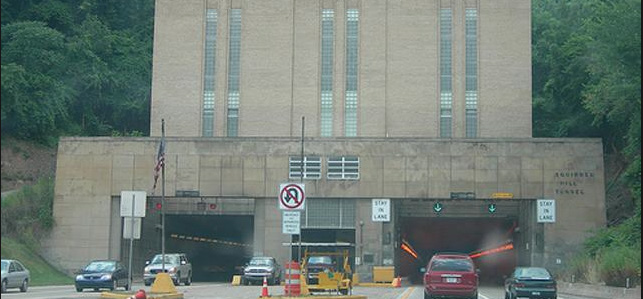Squirrel Hill Tunnels: Life in the slow lane
by Mike Lynch
Pittsburghers have a love-hate relationship with the Squirrel Hill Tunnels—or maybe they just love to hate them.
Every day, an average of 102,000 motorists venture through the 4,225 foot long tunnels, according to the Pennsylvania Department of Transportation (PennDOT), and it seems like they all try to do it at the exact same time, but why?
According to engineers like Asad Khattak of Old Dominion University, drivers see tunnels as a narrowing of the lanes, causing them to pump their brakes.
“The fact that you have a wall next to you is a very limiting factor,” he said in 2010 interview with The Virginian-Pilot.
Old Dominion psychology professor Mark Scerbo said claustrophobia also plays a role tunnel congestion.
“Some people who are nervous about confined places and dark places respond to that nervousness by slowing down,” he said in the same interview.
The traffic might be cuss-worthy today, but when they were first unveiled, the tunnels were a godsend. Drilling started September 7th, 1948, but city planners had been trying to think of a way to get people downtown from the eastern suburbs as early as the 1920s.
On September 15th, 1949, the passage was broken through to the Forward Avenue exit and 2,312 light fixtures with 4,624 bulbs, 8 ventilation fans, and three dead workers later, the tunnels were officially opened June 5th, 1953, according to PennDOT.
It cost $18 million, and it was the most expensive project taken on by the State Highways Department at the time. It completed the last link in the first eight-mile section of the Parkway East.
Starting last March, crews began work on a 3-year, $49.5 million reconstruction project. With its last renovation in 1983, the tunnel was due for a facelift. The project includes updates to the tunnel’s electrical, lighting and ventilation systems, as well as wall and ceiling repairs.
While the remodel will help the tunnel get up to date, PennDOT spokesman Steve Cowan said there’s nothing the construction crews can do to solve the traffic problem.
“While we don’t know whether the tunnel causes motorists to slow down,” he said, “we do know that as traffic builds, drivers typically slow or stop because of the movement of the vehicle in front of them.”
